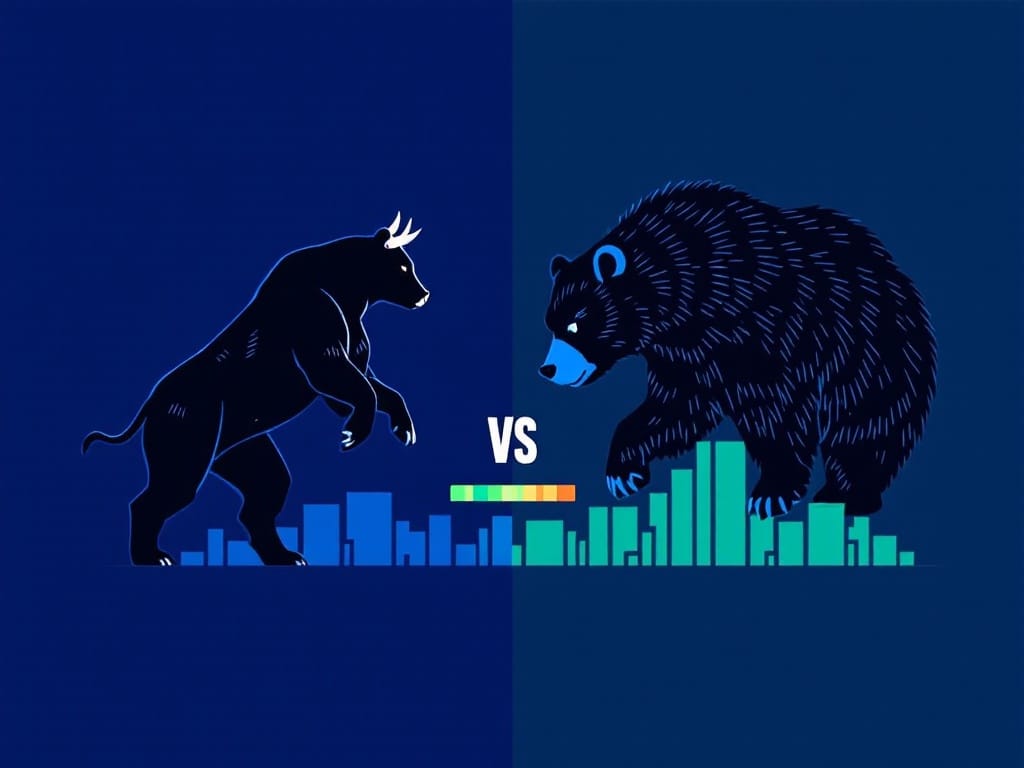What Is the Inverse Head and Shoulders Pattern?

Introduction to the Inverse Head and Shoulders Pattern
The inverse head and shoulders pattern stands as one of technical analysis's most powerful and reliable formations. In this comprehensive guide, we'll explore everything you need to know about identifying, confirming, and profiting from this crucial bullish reversal pattern.
What is the Inverse Head and Shoulders Pattern?
Imagine a chart pattern that looks like someone doing a yoga pose upside down—it’s not just whimsical, it’s profitable! The inverse head and shoulders pattern, also called the reverse head and shoulders, is a technical analysis formation signaling a potential bullish reversal. Think of it as the comeback story for stocks that have been on a losing streak.
The pattern consists of three main components: two smaller dips (shoulders) sandwiching one deeper dip (the head). It’s the financial equivalent of, “Wait for it… BOOM!”—a signal that prices are about to surge upward.
The inverse head and shoulders pattern emerges as a powerful bullish reversal signal during downtrends. Unlike its bearish counterpart, the inverse head and shoulders pattern forms at market bottoms, making it invaluable for identifying potential trend reversals. This formation consists of three distinctive valleys: two shallower ones (the shoulders) flanking a deeper central valley (the head).
Recent studies from 2024-2025 demonstrate that the inverse head and shoulders pattern boasts an impressive 80-93% success rate when properly identified. Even more remarkably, when traders combine the inverse head and shoulders pattern with volume confirmation, accuracy rates can reach up to 98%.
Why It Matters in Trading
Why should you care? Well, because this pattern is like having a cheat code in the trading world. It helps traders identify when a downtrend is about to reverse into an uptrend. If you’ve been waiting for a stock to climb out of the trenches, this pattern is your ally.
Once spotted, the bullish head and shoulders pattern offers a high-probability trade setup. It’s not foolproof—nothing in trading is—but it’s reliable enough to make seasoned traders sit up and take notice.
The significance of the inverse head and shoulders pattern extends far beyond its unique appearance. When trading the inverse head and shoulders pattern, you're essentially spotting the moment when market control shifts from bears to bulls. This pattern helps traders identify potential reversals before they become obvious to the broader market.
Think of the inverse head and shoulders pattern as a story told through price action. Each component reveals crucial information about the ongoing battle between buyers and sellers, with the pattern's completion signaling a likely victory for the bulls.

Understanding the Structure of the Inverse Head and Shoulders Pattern
Identifying the Left Shoulder: The Start of a Bullish Reversal
The left shoulder is where the magic starts. In this phase, the price dips, creating a valley. But here’s the catch—the subsequent rebound doesn’t lead to a full recovery, leaving traders scratching their heads. This dip hints that sellers are losing steam, which is a good sign for bulls.
The journey of every inverse head and shoulders pattern begins with the left shoulder. During this phase, selling pressure creates a notable low point, followed by a bounce. This initial valley represents the first sign that bearish momentum might be weakening.
For example, let’s say a stock drops from $50 to $40, then bounces back to $45. That initial dip is your left shoulder, a teaser of what’s to come.
When analyzing the left shoulder of an inverse head and shoulders pattern, look for:
- Significant trading volume during the decline
- A clear bounce from the low
- Price action that remains part of the existing downtrend
- A relatively symmetrical shape
The Head: The Lowest Dip
Now comes the dramatic head—the lowest point in the pattern. This is the belly flop of the stock’s price. It’s where buyers start whispering, “Is it time to step in?”
Picture a stock plunging to $35 from $45. This is where the bears think they’ve won, but little do they know, this is just the beginning of the bullish reversal.
Moving to the central component, the head formation in an inverse head and shoulders pattern marks the deepest point of the pattern. While this might appear as a bearish victory, it often comes with telling signs of weakness. During the head formation of an inverse head and shoulders pattern, traders should watch for:
- A deeper low than the left shoulder
- Decreasing volume compared to the left shoulder
- A strong bounce following the low
- Signs of buying pressure emerging
The Right Shoulder: Confirming the Uptrend
The right shoulder is the final clue traders need. Here, the price dips again, but this time it doesn’t fall as low as the head. Buyers are stepping up their game, and sellers are pretty much waving a white flag.
For instance, if the price dips to $38 instead of $35, that’s your right shoulder. This signals that the trend is reversing, and it’s time to plan your entry.
When analyzing the right shoulder in an inverse head and shoulders pattern, focus on:
- Similar price level to the left shoulder
- Lower volume than during head formation
- A strong push toward the neckline
- Clear signs of diminishing selling pressure
The Neckline: The Key to Pattern Confirmation
Ah, the neckline—the unsung hero of the pattern. This is the level connecting the highs of the two shoulders. When the price breaks above the neckline, it’s like a green light for traders.
The neckline is the ultimate confirmation of the inverted head and shoulders pattern. It’s where theory turns into action, and traders start placing their bets.
he neckline in an inverse head and shoulders pattern connects the high points between the shoulders. This crucial element serves as both resistance before the breakout and potential support afterward. When trading the inverse head and shoulders pattern, the neckline helps:
- Identify potential breakout levels
- Calculate profit targets
- Confirm pattern completion
- Plan entry strategies
How to Trade the Inverse Head and Shoulders Pattern
Recognizing the Pattern Formation
Spotting the pattern is half the battle. Look for the characteristic shape: a deep dip (head) flanked by two shallower dips (shoulders). Use tools like trendlines to mark the neckline for better clarity.
Successfully trading the inverse head and shoulders pattern starts with accurate identification. Look for these key elements:
- Three distinct valleys with the middle one (head) being the deepest
- Roughly symmetrical shoulders
- Clear neckline resistance
- Decreasing volume during pattern formation
- Increasing volume during breakout
When to Enter a Trade
The best time to jump in? When the price breaks above the neckline. This is your signal that the bullish head and shoulders pattern is in play. But don’t rush—wait for a confirmed breakout with strong volume.
Timing is crucial when trading the inverse head and shoulders pattern. The most reliable entry points occur when:
- Price breaks above the neckline with increased volume
- The breakout candle shows strong bullish momentum
- Volume confirms the breakout
- Market context supports the reversal
Setting Stop-Loss Points
No pattern is perfect, so protect yourself. Place a stop-loss below the right shoulder or the head. This way, if the trade turns on you, your losses are minimized.
Risk management remains essential when trading any pattern, including the inverse head and shoulders pattern. Consider these stop-loss placement strategies:
- Below the right shoulder (conservative approach)
- Below the head (aggressive approach)
- Below the neckline after breakout (intermediate approach)
Profit Targets: When to Exit
Set your sights on profit by calculating the distance between the head and the neckline. Add this distance to the breakout point to determine your target. For example, if the distance is $10, aim for a $10 gain from the neckline.
Calculate profit targets for the inverse head and shoulders pattern using these proven methods:
- Measure the distance from head to neckline
- Project this distance above the breakout point
- Use multiple profit targets for partial position exits
- Consider broader market context for target adjustment
Common Mistakes and Misinterpretations
Misidentifying the Pattern
Not every dip is a head and shoulders chart pattern. Avoid jumping the gun by confirming all components of the structure.
Avoid these common errors when identifying the inverse head and shoulders pattern:
- Forcing pattern recognition in choppy markets
- Ignoring volume confirmation
- Missing proper proportion between components
- Overlooking market context
Overestimating the Impact of Sloping Head and Shoulders
A sloping head and shoulders can still be valid, but steep angles might reduce reliability. Stay cautious and adjust your trades accordingly.
While a sloping inverse head and shoulders pattern can still be valid, consider:
- Steeper slopes may reduce reliability
- Adjust profit targets for sloping patterns
- Pay extra attention to volume confirmation
- Consider market context more carefully
Underestimating Bearish Signals in a Bullish Pattern
Even in a bullish setup, bearish signals like low volume can spell trouble. Don’t ignore these signs—they could save your portfolio.
Even within an inverse head and shoulders pattern, watch for warning signs:
- Weak volume on breakout
- Failed neckline retests
- Diverging indicators
- Broader market resistance
Real-World Examples of the Inverse Head and Shoulders Pattern
Historical Success Stories
Apple, Tesla, and even Bitcoin have showcased textbook inverse head and shoulders patterns. These patterns often precede significant rallies, making them favorites among traders.
Let's examine some notable inverse head and shoulders pattern examples:
- Bitcoin's 2019 reversal: A textbook inverse head and shoulders pattern preceded a major bull run
- Apple's 2020 COVID recovery: The inverse head and shoulders pattern signaled the end of the pandemic selloff
- Tesla's 2021 bottom formation: A perfect inverse head and shoulders pattern marked the end of the bear market
- S&P 500 major turning points: Multiple inverse head and shoulders patterns marked significant market bottoms
Times When the Pattern Failed
Not every pattern leads to profits. Sometimes, external factors like news events or low trading volume cause the pattern to fail.
Learning from failed inverse head and shoulders patterns proves equally valuable:
- Examples of pattern failures
- Warning signs that preceded the failures
- Risk management lessons
- Impact of market conditions
Conclusion: Why the Inverse Head and Shoulders Pattern is a Game Changer for Traders
The inverse head and shoulders pattern is more than just a pretty shape—it’s a tool that can transform your trading strategy. By understanding its structure, knowing when to enter and exit, and avoiding common mistakes, you’ll be better equipped to capitalize on bullish reversals.

FAQs About the Inverse Head and Shoulders Pattern
What Does a Head and Shoulders Pattern Indicate?
It signals a potential reversal in market trends.
Is a Head and Shoulders Pattern Bullish?
The traditional pattern is bearish, but the inverse head and shoulders is bullish. The inverse head and shoulders pattern indicates a potential bullish reversal in market trends, suggesting the end of a downtrend and the beginning of an uptrend.
How Can Traders Identify a Bullish Head and Shoulders Pattern?
Look for the classic inverted formation with a breakout above the neckline. Look for three consecutive lows, with the middle one (head) being the lowest, followed by a breakout above the neckline with increased volume.
What Are the Key Differences Between an Inverted Head and Shoulders and a Traditional Head and Shoulders?
The inverted version signals a bullish reversal, while the traditional pattern indicates a bearish trend. The inverse head and shoulders pattern forms at market bottoms and signals bullish reversals, while the traditional pattern forms at tops and signals bearish reversals.
How Reliable is the Inverse Head and Shoulders Pattern in Predicting Bullish Reversals?
While not foolproof, it’s one of the most reliable indicators when confirmed with volume and breakout. With proper identification and confirmation, the inverse head and shoulders pattern shows 80-93% reliability, increasing to 98% with volume confirmation.
FAQs About Funded Futures Network
What Types of Trading Does Funded Futures Network Support?
They support futures trading across multiple trading platforms and will answer questions the best that they can when it comes to technical issues and more.
How Can New Traders Start with Funded Futures Network?
Sign up for their evaluation programs to gain access to funded accounts. Once you sign up with FFN, you sign your rithmic documents and download one of the platforms provided by FFN if you don't already have your own to trade with.
What Resources Does Funded Futures Network Offer to Help Understand Chart Patterns?
They provide educational materials, webinars, and one-on-one onboarding calls.
What Is Funded Futures Network’s Success Rate with Futures Trading?
Their success rate depends on individual traders. If you have the discipline to manage your risk and the ability to take a losing day without blowing your account then you should get far.
How Does Funded Futures Network Support Traders in Market Downturns?
They offer risk management tools and guidance to navigate volatile markets. This is not a mentor, this is someone you can ask questions to regarding your funded account and suggestions.
Use this guide to master the inverse head and shoulders pattern and elevate your trading game. Now go forth and spot those bullish reversals like a pro!



